标签:des style blog http color os
In one embodiment, a source device detects a packet flow that meets criteria for multi-path forwarding, and forwards a probe packet on a primary path from the source device to a destination device, the probe packet carrying an indication to cause a plurality of transit devices along the primary path to add their respective local neighbor topology to the forwarded probe packet, and also to cause the destination device to compute a diverse path from the primary path based on the accumulated local neighbor topologies in the probe packet. Accordingly, the source device may receive a returned diverse path as computed by the destination device in response to the probe packet, and may thus forward the packet flow on the primary path and the diverse path from the source device to the destination device according to the multi-path forwarding.
The present disclosure relates generally to computer networks, and, more particularly, to diverse path computation for multi-path forwarding in limited visibility computer networks.
Low-power and Lossy Networks (LLNs), e.g., sensor networks, have a myriad of applications, such as smart grid, smart cities, home and building automation, etc. Various challenges are presented with LLNs, such as lossy links, low bandwidth, battery operation, low memory and/or processing capability, etc. Large-scale IP smart object networks pose a number of technical challenges. For instance, the degree of density of such networks (such as Smart Grid networks with a large number of sensors and actuators, smart cities, or advanced metering infrastructure or "AMI" networks) may be extremely high: it is not rare for each node to see several hundreds of neighbors. Also, links are usually shared (e.g., using wireless mesh or powerline communication (PLC) is networks) and provide very limited capacity (from a few Kbits/s to a several dozens of KBits/s).
The computation of diverse paths is a well-known technical challenge in networks using distance vector routing protocols, such as many LLN routing protocols. The ability to build diverse paths is important for the Internet of Things (IoT) for a number of critical/real-time applications where "1+1" techniques consisting of duplicating critical packets and sending them along diverse paths is a strong requirement. Indeed, for such packets, links are so lossy that sending a single copy along a path has a high probability of being lost (and being retransmitted, which involves additional delays), especially when the path diameter increases, particularly since the path‘s Packet Error Rate (PER) increases exponentially with the path length. Note that the computation of diverse paths may also be used to load-balance traffic flows across diverse paths (not just for 1+1).
Current diverse path mechanisms rely on knowledge of the full network topology, for example, using a link-state database, computation devices configured with full topology information, etc. In the case of typical routing protocols (e.g., Distance Vector) in LLNs, however, the routing topology is generally not fully known, i.e., nodes have limited visibility within the network.
According to one or more embodiments of the disclosure, a source device detects a packet flow that meets criteria for multi-path forwarding, and forwards a probe packet on a primary path from the source device to a destination device, the probe packet carrying an indication to cause a plurality of transit devices along the primary path to add their respective local neighbor topology to the forwarded probe packet, and also to cause the destination device to compute a diverse path from the primary path based on the accumulated local neighbor topologies in the probe packet. Accordingly, the source device may receive a returned diverse path as computed by the destination device in response to the probe packet, and may thus forward the packet flow on the primary path and the diverse path from the source device to the destination device according to the multi-path forwarding.
According to one or more additional embodiments of the disclosure, a network device (e.g., transit device) determines its local neighbor topology, and in response to receiving a probe packet on a primary path from a source device to a destination device, the probe packet carrying an indication that requests diverse path computation by the destination device of the primary path, adds its local neighbor topology to an accumulation, within the probe packet, of respective local neighbor topologies of other transit devices along the primary path. The network (transit) device may then forward the probe packet with the accumulation of local neighbor topologies toward the destination device along the primary path.
According to one or more still additional embodiments of the disclosure, destination device receives a probe packet on a primary path from a source device, the probe packet carrying an indication that requests that the destination device compute a diverse path of the primary path for a packet flow. As such, the destination device may retrieve the primary path of the probe packet and, from the probe packet, an accumulation of respective local neighbor topologies of transit devices along the primary path. Based on the accumulation of local neighbor topologies in the probe packet, the destination device may then compute a diverse path from the primary path, and returns the computed diverse path to the source device.
A computer network is a geographically distributed collection of nodes is interconnected by communication links and segments for transporting data between end nodes, such as personal computers and workstations, or other devices, such as sensors, etc. Many types of networks are available, ranging from local area networks (LANs) to wide area networks (WANs). LANs typically connect the nodes over dedicated private communications links located in the same general physical location, such as a building or campus. WANs, on the other hand, typically connect geographically dispersed nodes over long-distance communications links, such as common carrier telephone lines, optical lightpaths, synchronous optical networks (SONET), synchronous digital hierarchy (SDH) links, or Powerline Communications (PLC) such as IEEE 61334, IEEE P1901.2, and others. In addition, a Mobile Ad-Hoc Network (MANET) is a kind of wireless ad-hoc network, which is generally considered a self-configuring network of mobile routes (and associated hosts) connected by wireless links, the union of which forms an arbitrary topology.
Smart object networks, such as sensor networks, in particular, are a specific type of network having spatially distributed autonomous devices such as sensors, actuators, etc., that cooperatively monitor physical or environmental conditions at different locations, such as, e.g., energy/power consumption, resource consumption (e.g., water/gas/etc. for advanced metering infrastructure or "AMI" applications) temperature, pressure, vibration, sound, radiation, motion, pollutants, etc. Other types of smart objects include actuators, e.g., responsible for turning on/off an engine or perform any other actions. Sensor networks, a type of smart object network, are typically shared-media networks, such as wireless or PLC networks. That is, in addition to one or more sensors, each sensor device (node) in a sensor network may generally be equipped with a radio transceiver or other communication port such as PLC, a microcontroller, and an energy source, such as a battery. Often, smart object networks are considered field area networks (FANs), neighborhood area networks (NANs), etc. Generally, size and cost constraints on smart object nodes (e.g., sensors) result in corresponding constraints on resources such as energy, memory, computational speed and bandwidth.
FIG. 1?is a schematic block diagram of an example computer network?100?is illustratively comprising nodes/devices?200?(e.g., labeled as shown, "LBR," "11," "12," . . . "43," and described in?FIG. 2?below) interconnected by various methods of communication. For instance, the links?105?may be wired links or shared media (e.g., wireless links, PLC links, etc.) where certain nodes?200, such as, e.g., routers, sensors, computers, etc., may be in communication with other nodes?200, e.g., based on distance, signal strength, current operational status, location, etc. Those skilled in the art will understand that any number of nodes, devices, links, etc. may be used in the computer network, and that the view shown herein is for simplicity. Also, those skilled in the art will further understand that while the network is shown in a certain orientation, particularly with a "root" node, the network?100?is merely an example illustration that is not meant to limit the disclosure.

Data packets?140?may be exchanged among the nodes/devices of the computer network?100?using predefined network communication protocols such as certain known wired protocols, wireless protocols (e.g., IEEE Std. 802.15.4, WiFi, Bluetooth?, etc.), PLC protocols, or other shared-media protocols where appropriate. In this context, a protocol consists of a set of rules defining how the nodes interact with each other.
FIG. 2?is a schematic block diagram of an example node/device?200?that may be used with one or more embodiments described herein, e.g., as any of the nodes/devices shown in?FIG. 1?above. The device may comprise one or more network interfaces?210?(e.g., wired, wireless, PLC, etc.), at least one processor220, and a memory?240?interconnected by a system bus?250, as well as a power supply?260?(e.g., battery, plug-in, etc.).
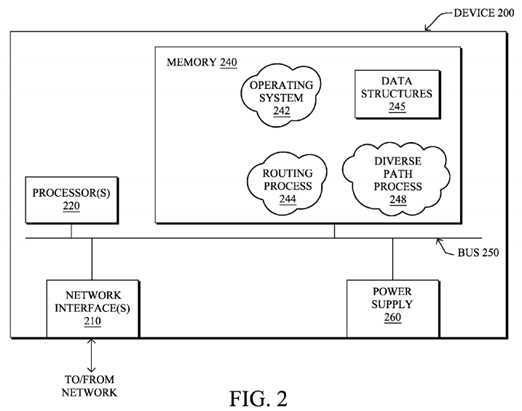
The network interface(s)?210?contain the mechanical, electrical, and signaling circuitry for communicating data over links?105?coupled to the network?100. The network interfaces may be configured to transmit and/or receive data using a variety of different communication protocols. Note, further, that the nodes may have two different types of network connections?210, e.g., wireless and wired/physical connections, and that the view herein is merely for illustration. Also, while the network interface?210?is shown separately from power supply260, for PLC the network interface?210?may communicate through the power supply?260, or may be an integral component of the power supply. In is some specific configurations the PLC signal may be coupled to the power line feeding into the power supply.
The memory?240?comprises a plurality of storage locations that are addressable by the processor?220?and the network interfaces?210?for storing software programs and data structures associated with the embodiments described herein. Note that certain devices may have limited memory or no memory (e.g., no memory for storage other than for programs/processes operating on the device and associated caches). The processor?220?may comprise necessary elements or logic adapted to execute the software programs and manipulate the data structures?245. An operating system?242, portions of which are typically resident in memory?240?and executed by the processor, functionally organizes the device by, inter alia, invoking operations in support of software processes and/or services executing on the device. These software processes and/or services may comprise routing process/services?244, and an illustrative diverse path process?248, as described herein. Note that while diverse path process?248is shown in centralized memory?240, alternative embodiments provide for the process to be specifically operated within the network interfaces?210.
It will be apparent to those skilled in the art that other processor and memory types, including various computer-readable media, may be used to store and execute program instructions pertaining to the techniques described herein. Also, while the description illustrates various processes, it is expressly contemplated that various processes may be embodied as modules configured to operate in accordance with the techniques herein (e.g., according to the functionality of a similar process). Further, while the processes have been shown separately, those skilled in the art will appreciate that processes may be routines or modules within other processes.
Routing process (services)?244?contains computer executable instructions executed by the processor?220?to perform functions provided by one or more routing protocols, such as proactive or reactive routing protocols as will be understood by those skilled in the art. These functions may, on capable devices, be configured to manage a routing/forwarding table (a data structure?245) containing, e.g., data used to make routing/forwarding decisions. In particular, in proactive routing, connectivity is is discovered and known prior to computing routes to any destination in the network, e.g., link state routing such as Open Shortest Path First (OSPF), or Intermediate-System-to-Intermediate-System (ISIS), or Optimized Link State Routing (OLSR). Reactive routing, on the other hand, discovers neighbors (i.e., does not have an a priori knowledge of network topology), and in response to a needed route to a destination, sends a route request into the network to determine which neighboring node may be used to reach the desired destination. Example reactive routing protocols may comprise Ad-hoc On-demand Distance Vector (AODV), Dynamic Source Routing (DSR), DYnamic MANET On-demand Routing (DYMO), etc. Notably, on devices not capable or configured to store routing entries, routing process?244?may consist solely of providing mechanisms necessary for source routing techniques. That is, for source routing, other devices in the network can tell the less capable devices exactly where to send the packets, and the less capable devices simply forward the packets as directed.
Notably, mesh networks have become increasingly popular and practical in recent years. In particular, shared-media mesh networks, such as wireless or PLC networks, etc., are often on what is referred to as Low-Power and Lossy Networks (LLNs), which are a class of network in which both the routers and their interconnect are constrained: LLN routers typically operate with constraints, e.g., processing power, memory, and/or energy (battery), and their interconnects are characterized by, illustratively, high loss rates, low data rates, and/or instability. LLNs are comprised of anything from a few dozen and up to thousands or even millions of LLN routers, and support point-to-point traffic (between devices inside the LLN), point-to-multipoint traffic (from a central control point such at the root node to a subset of devices inside the LLN) and multipoint-to-point traffic (from devices inside the LLN towards a central control point).
An example implementation of LLNs is an "Internet of Things" network. Loosely, the term "Internet of Things" or "IoT" may be used by those in the art to refer to uniquely identifiable objects (things) and their virtual representations in a network-based architecture. In particular, the next frontier in the evolution of the Internet is the ability to connect more than just computers and communications devices, but rather the ability to connect "objects" in general, such as lights, appliances, vehicles, HVAC (heating, ventilating, and air-conditioning), windows and window shades and blinds, doors, locks, etc. The "Internet of Things" thus generally refers to the interconnection of objects (e.g., smart objects), such as sensors and actuators, over a computer network (e.g., IP), which may be the Public Internet or a private network. Such devices have been used in the industry for decades, usually in the form of non-IP or proprietary protocols that are connected to IP networks by way of protocol translation gateways. With the emergence of a myriad of applications, such as the smart grid, smart cities, and building and industrial automation, and cars (e.g., that can interconnect millions of objects for sensing things like power quality, tire pressure, and temperature and that can actuate engines and lights), it has been of the utmost importance to extend the IP protocol suite for these networks.
An example protocol specified in an Internet Engineering Task Force (IETF) Internet Draft, entitled "RPL: IPv6 Routing Protocol for Low Power and Lossy Networks"<draft-ietf-roll-rpl-19> by Winter, at al. (Mar. 13, 2011 version), provides a mechanism that supports multipoint-to-point (MP2P) traffic from devices inside the LLN towards a central control point (e.g., LLN Border Routers (LBRs) or "root nodes/devices" generally), as well as point-to-multipoint (P2MP) traffic from the central control point to the devices inside the LLN (and also point-to-point, or "P2P" traffic). RPL (pronounced "ripple") may generally be described as a distance vector routing protocol that builds a Directed Acyclic Graph (DAG) for use in routing traffic/packets?140, in addition to defining a set of features to bound the control traffic, support repair, etc. Notably, as may be appreciated by those skilled in the art, RPL also supports the concept of Multi-Topology-Routing (MTR), whereby multiple DAGs can be built to carry traffic according to individual requirements.
Also, a directed acyclic graph (DAG) is a directed graph having the property that all edges are oriented in such a way that no cycles (loops) are supposed to exist. All edges are contained in paths oriented toward and terminating at one or more root nodes (e.g., "clusterheads or "sinks"), often to interconnect the devices of the DAG with a larger infrastructure, such as the Internet, a wide area network, or other domain. In addition, a Destination Oriented DAG (DODAG) is a DAG rooted at a single destination, i.e., at a single DAG root with no outgoing edges. A "parent" of a particular node within a DAG is an immediate successor of the particular node on a path towards the DAG root, such that the parent has a lower "rank" than the particular node itself, where the rank of a node identifies the node‘s position with respect to a DAG root (e.g., the farther away a node is from a root, the higher is the rank of that node). Note also that a tree is a kind of DAG, where each device/node in the DAG generally has one parent or one preferred parent. DAGs may generally be built (e.g., by a DAG process of routing process?244) based on an Objective Function (OF). The role of the Objective Function is generally to specify rules on how to build the DAG (e.g. number of parents, backup parents, etc.).
FIG. 3?illustrates an example simplified DAG that may be created, e.g., through the techniques described above, within network?100?of?FIG. 1. For instance, certain links?105?may be selected for each node to communicate with a particular parent (and thus, in the reverse, to communicate with a child, if one exists). These selected links form the DAG?310?(shown as solid bolded lines), which extends from the root node toward one or more leaf nodes (nodes without children). Traffic/packets?140?(shown in?FIG. 1) may then traverse the DAG?310?in either the upward direction toward the root or downward toward the leaf nodes, particularly as described herein. In addition, the creation of the DAG may also provide for one or more alternate parents (next-hops). Note that while a DAG?310?is shown, other distance vector routing topologies may be created, and a DAG, particularly one created using RPL, is merely one example of a routing protocol topology that may be created and utilized according to the techniques described herein.
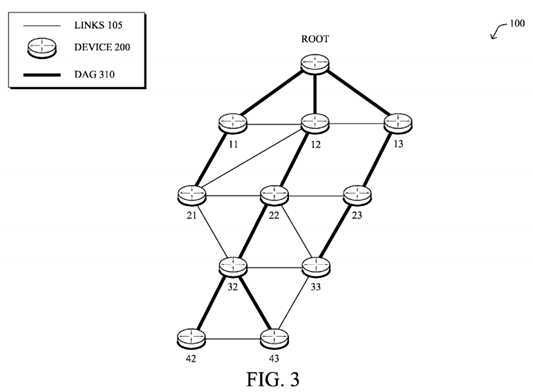
As noted above, the computation of diverse paths is a well-known technical challenge in networks using distance vector routing protocols, such as many LLN routing protocols. The ability to build diverse paths is important for the Internet of Things (IoT) for a number of critical/real-time applications where multi-path forwarding techniques consisting of load-balancing traffic across diverse paths, or particularly duplicating critical packets and sending them along diverse paths, is a strong requirement. Indeed, for such packets, links are so lossy that sending a single copy along a path has a high probability of being lost (and being retransmitted, which involves additional delays), especially when the path diameter increases, particularly since the path‘s Packet Error is Rate (PER) increases exponentially with the path length.
Said differently, supporting multi-path forwarding, such as redundancy protection techniques, e.g., "1:1" protection (where the diverse path is used only in response to detecting a failure of the primary path) or "1+1" protection (where two diverse packets are sent, one on the primary path and one on the/each diverse path), is an important factor in many LLNs making use of Distance Vector routing protocols. For some applications in particular, the delivery of a critical packet is an absolute requirement. As one illustrative example (among many), Industrial Automation has specified several classes of traffic:
Current LLN solutions are typically provide adequate service for the monitoring classes 4 and 5, which have the lowest reliability and real-time requirements, and sometimes the non-critical portions of class 3. However, in order to provide reliable service for the higher classes of traffic, e.g., class 3 and above, redundancy protection techniques (using diverse paths) may be necessary in such networks.
As also noted above, current diverse path mechanisms rely on knowledge of the full network topology, for example, using a link-state database, computation devices configured with full topology information, etc. In the case of typical routing protocols (e.g., Distance Vector) in LLNs, however, the routing topology is generally not fully known, and redundancy protection techniques for limited visibility networks have generally been unavailable or inefficient.
The techniques herein provision on-demand diverse paths between two arbitrary nodes in a limited visibility computer network (e.g., for a limited period of time). In particular, the techniques allow a source/sender node to dynamically activate multi-path forwarding (e.g., load-balancing and/or redundancy protection) for a flow along a primary path, and generally rely on a receiving/destination node of the primary path to compute the diverse path based on the gathering of topological information in a packet (e.g., a probe or a first packet of the flow) sent along the primary path from the source node.
Specifically, according to one or more embodiments of the disclosure as described in detail below, a source device detects a packet flow that meets criteria for multi-path forwarding, and forwards a probe packet on a primary path from the source device to a destination device, the probe packet carrying an indication. Based on this indication, transit devices along the primary path add their local neighbor topology to an accumulation, within the probe packet, of respective local neighbor topologies of other transit devices along the primary path. In addition, upon receiving the probe packet with the indication, the destination device computes a diverse path from the primary path based on the accumulated local neighbor topologies in the probe packet, and returns the diverse path to the source device. Accordingly, upon receiving the returned diverse path as computed by the destination device, the source device may thus forward the packet flow on the primary path and the diverse path from the source device to the destination device according to the multi-path forwarding.
Illustratively, the techniques described herein may be performed by hardware, software, and/or firmware, such as in accordance with the diverse path process?248, which may contain computer executable instructions executed by the processor?220?(or independent processor of interfaces?210) to perform functions relating to the techniques is described herein, e.g., in conjunction with routing process?244. For example, the techniques herein may be treated as extensions to conventional protocols, such as one or more illustrative routing protocols (e.g., RPL), and as such, may be processed by similar components understood in the art that execute those protocols, accordingly. It is worth noting that most, if not all, of the current routing protocols designed for LLNs or other types of limited visibility networks are distance vector, whether proactive or reactive, where it is often extremely challenging to provide diverse paths. The techniques herein may be applicable to all distance vector routing protocols designed for limited visibility networks (e.g., LLNs, IoT domains, etc.), and is not specifically limited to any of them.
Note also that functionality of the diverse path process?248?may be specifically configured for whether the device is a source (originator) node, an intermediate (transit) node, or a destination (receiver) node. However, in an illustrative embodiment, each node?200?may be generally capable of functioning as any type of node/device, that is, depending upon the traversed primary path in question.
Operationally, the first component of the illustrative techniques herein is to dynamically determine, by source devices (senders) of traffic, when to trigger multi-path (diverse path) forwarding, such as for redundancy protection for critical traffic, e.g., for either "1:1" protection, "1+1" protection, or load-balancing, optionally for a specific period of time. That is, in contrast with many current approaches, the source device, such as the root device or any other device?200?in the network100, first determines "on-the-fly" whether or not a packet flow requires multi-path forwarding. By detecting whether a packet flow meets certain defined criteria for multi-path forwarding, the techniques herein may generally provide that the techniques be used for a limited subset of all traffic (e.g., to reduce overhead in the network). In particular, collecting neighborhood information as described below may be costly, thus the source may decide to limit the use of the techniques herein for very critical traffic, and also optionally for only those destination devices that are within a pre-defined distance.
This is, the decision to apply multi-path forwarding to particular traffic flows may is be driven by policy according to matching specific criteria, such as various rules defining particular flow characteristics, specific scenarios or circumstances, etc. For example a specific set of events may make a specific notification extremely important, e.g., alerts, potentially for a specific amount of time. Such criteria/rules may be obtained from a network management server (NMS) or other management device, such as during the bootstrapping process, and may be dynamically updated, such as due to varying network conditions or varying application determinations (e.g., an indication from higher layer that a critical packet flow may be experiencing a low packet delivery rate, etc.). Note that critical packet flows are frequent in the IoT, to send a set of critical event information, download an urgent security patch on a remote device, etc.
Illustratively, example criteria to be met for multi-path forwarding may comprise, among others, particular traffic types, priorities, or classes, particular applications sourcing the traffic, particular destination devices (such as an access control list (ACL)), destinations within a configured distance (e.g., more of a limiting criteria in addition to one or more other criteria), traffic during particular times, traffic during particular events, etc. In one specific embodiment, the criteria may even simply be to use the techniques herein for multi-path forwarding in response to a source device being configured to be able to generate critical packets, generally (e.g., a device whose sole purpose is to generate critical alarms).
Once the source device determines that multi-path forwarding is required for a packet flow, it forwards a "probe packet" as described herein on a primary path to a corresponding destination device for the flow. For instance,?FIG. 4?illustrates an example (and simplified) packet?400, that may generally comprise a header?410?used to forward the packet?400?(e.g., with source?412?and destination?414), and corresponding payload?420, as will be understood by those skilled in the art. Generally, the header?410?(e.g., an IPv6 Hop-by-Hop header) of the probe packet?400?carries a multi-path forwarding indicator?416?(indication?416, along with other fields?418?and?419, as described herein), such as a bit, flag, or TLV, that indicates to one or more transit devices along the primary path as well as the destination device of the path that the techniques herein for multi-path forwarding have been triggered for the corresponding (identified) packet flow, namely, is requesting diverse path computation by the destination device.
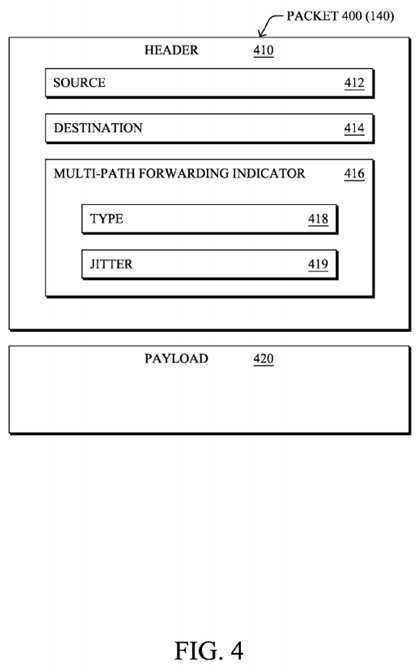
For instance, assume, as shown in?FIG. 5, that a source device such as the root device (or any other arbitrary device) determines that a packet flow along primary path?550?is to receive multi-path forwarding. The illustrative primary path?550may comprise Root-12-22-32-42, such that the root node is the source device, nodes?12,?22, and?32?are transit (or intermediate) devices, and node?42?is the destination device. The indication?416?sent within the probe packet?400?along the primary path?550?informs the visited nodes that the multi-path forwarding trigger has been applied to the corresponding flow, thus causing any transit device along the primary path to add their respective "local neighbor topology" to the forwarded probe packet?400.
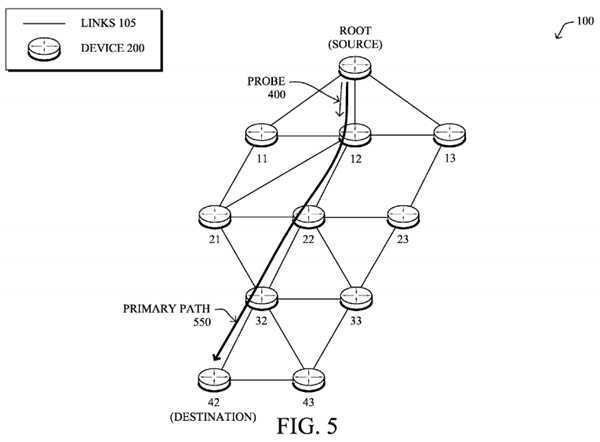
In particular, in LLNs, and in any other type of network or routing protocol where the network topology is not generally fully known by the source nodes generating the traffic (e.g., distance vector routing protocols), diverse paths cannot be created by the source nodes without first gathering topology information. (Note that the techniques herein a agnostic of the routing protocol in use.) Accordingly, as shown in?FIG. 6, for example, the techniques herein provide for a mechanism to accumulate localized topology information, where transit devices (e.g., nodes?12,?22, and?32) receiving a probe packet with the indication?416?may add their local neighbor topology to an accumulation?630, within the probe packet?400, of respective local neighbor topologies (added fields?632,?634,?636, etc., respectively) of other transit devices along the primary path550.
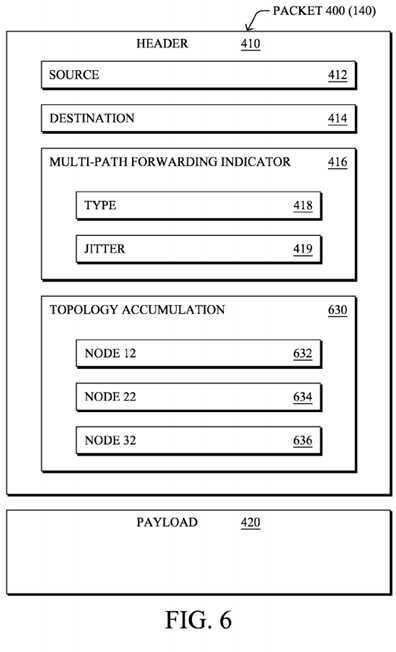
That is, with reference also to?FIG. 7, when receiving a probe packet?400?on a primary path?550?that carries an indication416?requesting diverse path computation by the destination device, each device/router visited processes the probe packet to add not only its own address, but also the list of its reachable neighbors?632/634/636. The corresponding local neighbor topology may be determined, for example, thanks to IPv6 neighbor discovery, and may generally include a listing of one or more reachable neighbor nodes, as well as, optionally, those reachable neighbors‘ neighbors, which may be obtained thanks to a local multicast message as will be appreciated by those skilled in the art. For example, as depicted in?FIG. 7, node?12?may receive the probe packet?400, and inserts its local neighbor topology?632?into the packet, which may comprise neighbor nodes?11,?13,?21,?22, and?23, and their corresponding connectivity (links). Note that node?23?is not directly reachable by node?12, but is reachable by node?13?and node?22, and thus may be included. Illustratively, also, the neighbor topology may only comprise downstream nodes as shown, or may comprise any reachable neighbor, whether upstream or downstream. Similarly, node?22?may add topology?634?to the packet?400?that includes nodes?21,?23,?32?and?33, while node32?may further add topology?636?including nodes?33,?42, and?43, each along with their corresponding connectivity.

In dense environments, a transit device/router may choose to select a subset of reachable neighbors for the correspondingly local neighbor topology. For example, to prune the list of included neighbors, a transit device may choose to only include neighbors that are reachable from the neighbors of the previous-hop and a next-hop from the transit device along the primary path, thus ensuring that the included neighbors can provide alternate routes from the previous hop. This in turns allows the destination device, responsible for the computation of a diverse path as described below, to discover a small but required subset of the topology for the required diverse paths in a distance vector proactive routing network. Furthermore, various compression techniques may be used for collecting the required "neighborhood" information?630, such as IP address compression, use of local labels or tags uniquely identify nodes in the network, etc.
The transit nodes forward the probe packet?400?with the accumulation of local neighbor topologies?630?toward the destination device along the primary path?550. Upon receiving the packet at the destination device (e.g., node?42), and upon detecting that the indication?416?is present that requests that the destination device compute a diverse path of the primary path for a packet flow, the destination device may thus attempt to compute a diverse path based on the accumulated local neighbor topologies in the probe packet. Note that the primary path may be computed according to the routing protocol, e.g., DAG?310?(though not limited to RPL), and the diverse path computation makes use of the local topology discovery, and is computed by the destination device, e.g., using a lightweight path computation algorithm.
Specifically, the receiving destination device retrieves the primary path?550?of the is probe packet (e.g., as recorded in the packet itself) as well as the accumulation?630?of respective local neighbor topologies of transit devices along the primary path. As shown in?FIG. 8, by inspecting the primary path followed by the probe packet?400, and based on the accumulation of local neighbor topologies in the probe packet, the destination device may then compute a diverse path?850?(Root-13-23-33-43-42), e.g., after removing the set of traversed routers (transit devices).
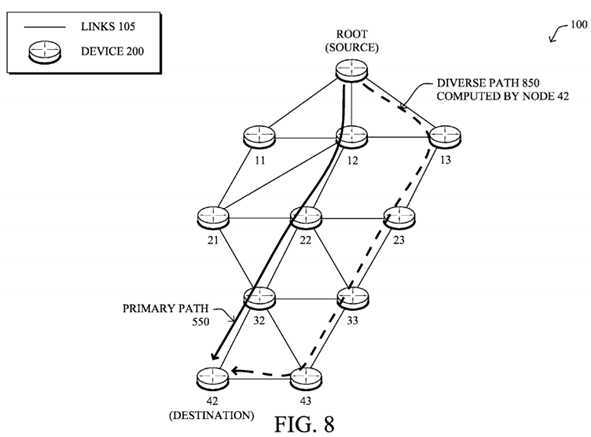
Note that the algorithm chosen for diverse path computation could be as simple as the two-step approach (remove all traversed routers and compute a diverse path) or more sophisticated such as the known Bandhari algorithm. In general computing diverse paths can be complex, and in most cases is NP-Complete, however, in the embodiments herein, this is not the case because the primary path?550?follows the path computed by the routing protocol (e.g., according to the objective function), regardless of the specific routing protocol. So the only computation task for which the destination router need be responsible is to avoid the set of traversed links/routers to compute the diverse path?850?thanks to the neighborhood information accumulated by the probe packet, which is a relatively simple and minimally intensive task.
In accordance with one or more specific embodiments, if more granularity is required, a second bit/indicator called "type"418?in?FIG. 4?above is defined that specifies whether the diverse path should be computed as a link-diverse path or a node-diverse (i.e., link+node-diverse) path. In the later case, if no node-diverse paths can be found by the destination device, a fall-back option may be to compute a link-diverse path (and optionally record that fact in the reply to the source device).
As shown in?FIG. 9, once the diverse path has been computed, the destination device may return the computed diverse path back to the source device in a message?940, such as a newly defined IPv6 unicast message (e.g., on the primary path, the diverse path, or any other path back to the source device). Upon receiving such a message?940, the source device may install the diverse path?850?in its routing table (a data structure?245), and activates the multi-path forwarding (e.g., 1+1, load-balancing, etc.), thus forwarding is the packet flow on the primary path?550?and the diverse path?850?from the source device (e.g., the root node) to the destination device (e.g., node?42) according to the multi-path forwarding. For example, for 1+1 protection, duplicated packets may be marked with an appropriate "duplicated packet" flag (by the source device or the application originating the flow) along both paths. The destination device may then correspondingly receive the packet flow on the primary path and the diverse path from the source device, and processes the received packet flow according to the chosen multi-path forwarding mechanism (e.g., load-balancing, redundancy protection such as 1+1 or 1:1, etc.).

Notably, in one embodiment, the probe packet?400?may be an initial (first) packet of the actual packet flow, where the indication?416?(and added information?630) is inserted within the packet header?410?of the original packet, that is, where the payload?420?corresponds to that of the packet flow. In this instance, the destination device may cache the first packet for redundancy processing of the copy to be received later over the computed diverse path, and uses the "piggybacked" local neighbor topology information?630?to compute the diverse path. (Note that for this particular embodiment, the indication?416may be the "duplicated packet" flag as mentioned above.) Alternatively, in yet another embodiment, the probe packet?400?is an explicit probe packet that may be sent with the indication?416?prior to an initial packet of the packet flow, such that the gathered neighborhood information?630?may be within header?410, or else may be part of the payload?420?of the packet, accordingly. (Note that still further, a two-step probe process may be executed in a specific embodiment, where a first probe indicates the multi-path forwarding, and a second probe then later gathers neighborhood information, such as after having given the transit nodes time to collect such information.) That is, when an explicit probe packet is utilized, upon detecting a packet flow to which multi-path forwarding is to be applied, the source device may first send out the probe packet to generate the diverse path, and then begins to forward the packet flow, e.g., over both paths.
There are circumstances where no diverse paths are available, or, in fact, where finding diverse paths is not possible even where diverse paths exist, but would not be is found because of the computation of the diverse path after having already selected the first path according to the routing protocol in use. As shown in?FIG. 10A, for example, this condition is referred to as the diversity "trap" problem, such as where if node?23?were removed from the topology, the original primary path?550, by utilizing nodes?22?and?32, removes any possibility of a node-diverse path. Note that though this is very unlikely in LLNs (or other types of networks) where the network density is high, it may be acceptable in certain situations to not have a diverse path since being always capable of finding diverse paths is NP-Complete and may require knowing the entire topology database, which is not a viable/scalable solution for computing diverse paths between an arbitrary pair of nodes in distance vector routing environment.
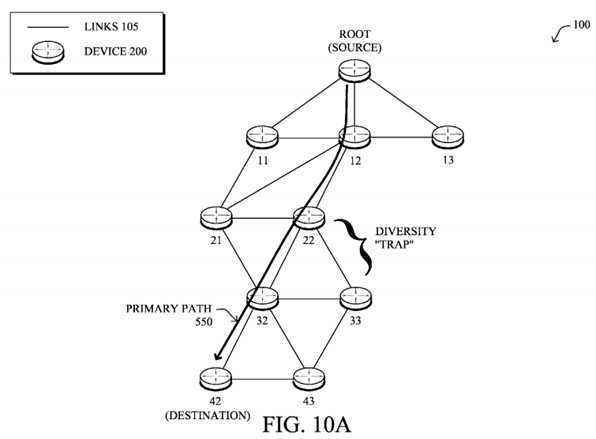
According to one or more embodiments herein, in the event that no diverse path can be found by the destination device, a notice?940?may be returned to the source device indicating that no diverse path could be computed (e.g., a newly specified flag may be set that reports such network condition). The source device (or destination device) may, in turn, notify the issue to a management device (e.g., an NMS, a central intelligence controller or "CIC," etc.). In addition, or alternatively, the source device may also modify the primary path?550?so as to increase the chance for the destination device to find a diverse path. For example, as shown in?FIG. 10B, the source device may compute a new primary path?550-A to the destination device (e.g., Root-11-21-32-42), and may thus forwarding a new probe packet?400?on the new primary path550-A to request re-computation of a diverse path based on the new primary path and associated local neighbor topologies630?accumulated in the new probe packet. Upon receiving such a new probe packet?400?on a new primary path?550-A, as shown in?FIG. 10C, the destination device may then attempt again to compute a diverse path?850-A (e.g., Root-12-23-33-43-42) based on a new accumulation of local neighbor topologies in the new probe packet, accordingly.
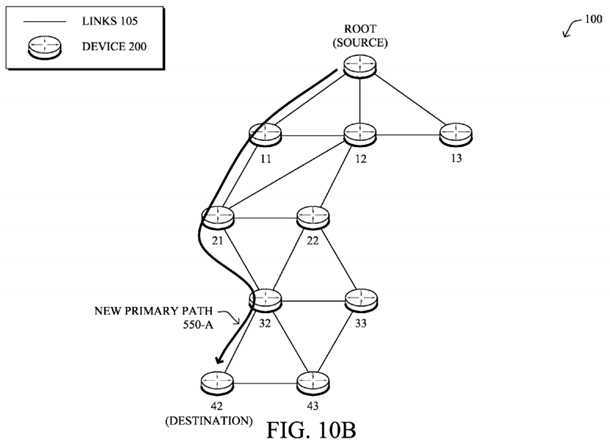
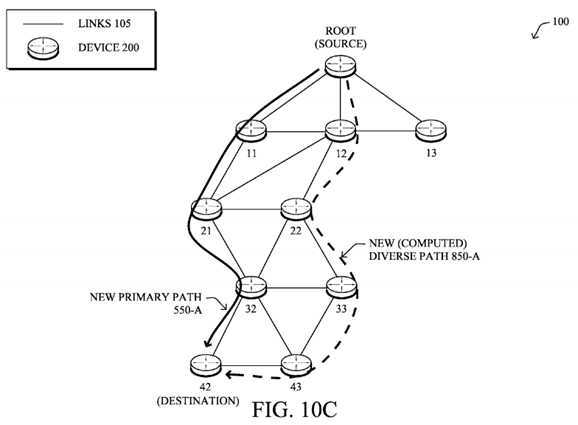
In another embodiment, the techniques herein may be additionally configured to absorb the jitter due to the additional delay for the duplicated packet flow, particularly where the initial packet of the flow is used as the probe packet?400?where there is an additional delay before the second packet is sent along the diverse path. Such a is functionality may be used in networks, for example, where both copies of the same packet are used for "single-ended protection" or on-the-fly packet reconstruction. Single-ended protection allows the destination of a packet to dynamically select which one of the two received packets should be consumed and is potentially less altered by error (which can be determined using a number of well-known error code detection mechanisms). That is, single-ended protection requires the reception of both packets at substantially the same time. In the later case, some techniques are sometimes used so as to reconstruct a packet from two altered copies of the same packet, which also requires receiving both copies of the packet at the same time to avoid buffering issues.
Where applications may require systematically receiving both copies of the same packet at substantially the same time (for example for error detection and correction), then it may be beneficial to bound the jitter between copies of the same packet (e.g., including the initial packet). As such, the probe packet may further carry a jitter-based indication?419?to cause the destination device to configure itself to wait a configured time after receiving a particular packet for the packet flow (on either the primary path or the diverse path) for a copy of a that packet (on either the opposing diverse path or the primary path, respectively). For example, a newly defined IPv6 header bit?419, e.g., called the NJ (No Jitter) bit, may be set, such that if the NJ bit is set, upon receiving the first copy of the packet, the destination device caches the first packet for a configurable period of time. If the second copy of the packet is received before the expiration of the timer, both copies are simultaneously delivered to the ultimate receiver (e.g., an end-user device or application in communication with the destination device), otherwise the first packet is delivered without further delay. Note that in yet another embodiment, the timer can be dynamically computed by the destination device according to historical data, recorded path length, etc.
FIG. 11?illustrates an example simplified procedure for on-demand diverse path computation for limited visibility computer networks in accordance with one or more embodiments described herein, particularly from the perspective of the source device. The procedure?1100?may start at step?1105, and continues to step?1110, where, as described in greater detail above, a source device (e.g., the root as shown above, or any is other node within the network?100) may detect a packet flow that meets one or more criteria for multi-path forwarding, such as a type, priority, etc. In response, in step?1115, the source device forwards a probe packet?400?(e.g., an initial packet of the flow or an explicit probe) on a primary path?550from the source device to a destination device (e.g., node?42). Specifically, as described herein, the probe packet?400carries an indication?416?to cause a plurality of transit devices along the primary path (e.g., nodes?12,?22,?32) to add their respective local neighbor topology to the forwarded probe packet (into field?630). In addition, the indication?416?also causes the destination device to compute a diverse path?850?from the primary path based on the accumulated local neighbor topologies in the probe packet.
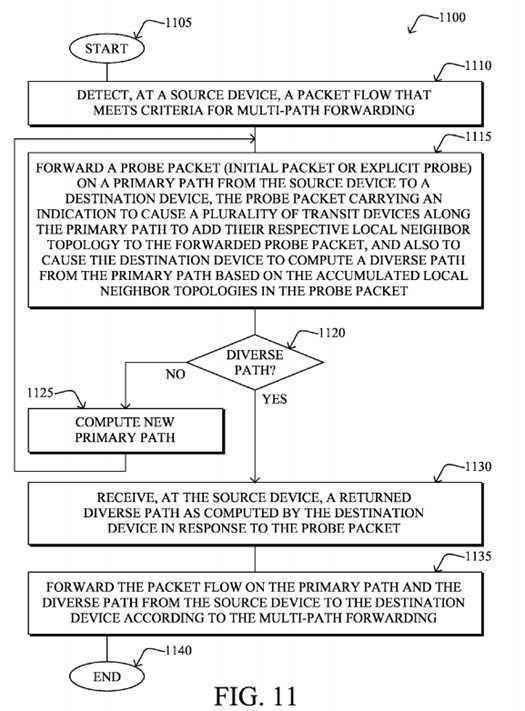
If there is no diverse path computed in step?1120, then in step?1125?the source device may receive the corresponding notification from the destination device, and in step?1125?may compute a new primary path?550-A, and returns to?1115?to attempt to find a new (existing) diverse path?850-A, accordingly. However, if there is a diverse path computed in step?1120, then in step?1130?the source device receives the returned diverse path?850?as computed by the destination device in response to the probe packet. The source device may then forward the packet flow on the primary path?550?and the diverse path?850?from the source device to the destination device according to the multi-path forwarding in step?1135. Notably, this example may illustrate either load-balancing or 1+1 redundancy protection as the multi-path forwarding technique in step?1135?(using both paths at once), though the diverse paths may also be used for 1:1 protection, where the diverse path (and hence step?1135) utilizes the diverse path?850?only in response to detecting a failure of the primary path550. The procedure?1100?illustratively ends in step?1140.
In addition,?FIG. 12?illustrates an example simplified procedure for on-demand diverse path computation for limited visibility computer networks in accordance with one or more embodiments described herein, particularly from the perspective of the transit device. The procedure?1200?may start at step?1205, and continues to step?1210, where, as described in greater detail above, a network device (transit device, e.g., node?22) determines its local neighbor topology, such as a subset according to one or more of the is embodiments described above. When receiving a packet in step?1215?on a primary path550?from a source device to a destination device (e.g., from the root to node?42), the transit device may determine whether it is a probe packet carrying an indication that requests diverse path computation by the destination device of the primary path. If so, then in step?1220?the transit device adds its local neighbor topology to an accumulation, within the probe packet, of respective local neighbor topologies?630?of other transit devices along the primary path. Once processed, in step?1225, the transit device may forward the probe packet?400?with the accumulation of local neighbor topologies (field?630) toward the destination device along the primary path, and the procedure may then end in step?1130.
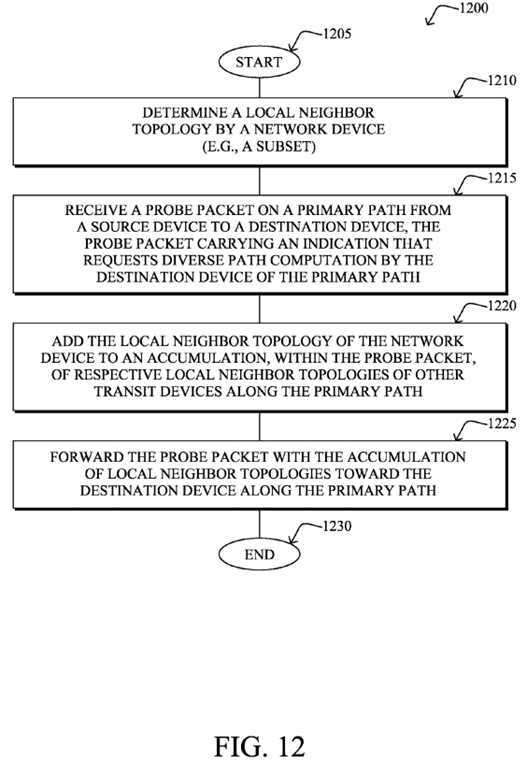
Lastly,?FIG. 13?illustrates an example simplified procedure for on-demand diverse path computation for limited visibility computer networks in accordance with one or more embodiments described herein, particularly from the perspective of the destination device. The procedure?1300?may start at step?1305, and continues to step?1310, where, as described in greater detail above, a destination device (e.g., node?42) may receive a probe packet?400?on a primary path?550?from a source device (e.g., root node), where as noted, the probe packet carries an indication?416?that requests that the destination device compute a diverse path of the primary path for a packet flow. In response, in step?1315, the destination device may retrieve the primary path of the probe packet (e.g., from the packet itself), and also retrieves, from the probe packet in step1320, an accumulation of respective local neighbor topologies?630?of transit devices along the primary path. As such, in step?1325?the destination device may compute a diverse path?850?from the primary path?550?based on the accumulation of local neighbor topologies in the probe packet.

Note that if there is no diverse path that may be computed in step?1330, then in step?1335?the destination device may return a notice?940?to the source device of the computational failure, and the procedure ends (albeit, generally awaiting a new probe on new primary path?550-A, as noted above).
If there is a diverse path?850?in step?1330, however, then in step?1340?the destination device returns the computed diverse path in notice?940, and may then begin is receiving the packet flow on the primary path?550?and the diverse path?850?from the source device in step?1345. As such, in step?1350, the destination device may process the received packet flow according to multi-path forwarding as described in detail above, such as handling duplicate packets (e.g., while managing jitter), etc. The procedure?1300?illustratively ends in step?1355.
It should be noted that while certain steps within procedures?1100-1300?may be optional as described above, the steps shown in?FIGS. 11-13?are merely examples for illustration, and certain other steps may be included or excluded as desired. Further, while a particular order of the steps is shown, this ordering is merely illustrative, and any suitable arrangement of the steps may be utilized without departing from the scope of the embodiments herein. Moreover, while procedures?1100-1300?are described separately, certain steps from each procedure may be incorporated into each other procedure, and the procedures are not meant to be mutually exclusive.
The techniques described herein, therefore, provide for on-demand diverse path computation for limited visibility computer networks. In particular, the techniques herein provide an efficient 1+1 (or 1:1) protection mechanism for distance vector routing, as well as a load-balancing mechanism, particularly for LLNs or other networks with limited visibility, without requiring off-line computation, and regardless of the routing protocol in use. As such, the techniques increase the reliability for critical packets in limited visibility networks, and are particularly suited for constrained networks.
While there have been shown and described illustrative embodiments that provide for on-demand diverse path computation for limited visibility computer networks, it is to be understood that various other adaptations and modifications may be made within the spirit and scope of the embodiments herein. For example, the embodiments have been shown and described herein with relation to LLNs and in particular the RPL protocol. However, the embodiments in their broader sense are not as limited, and may, in fact, be used with other types of limited visibility networks and/or protocols, distance vector or not. Also, while the diverse paths are computed to a single destination device, in networks with point-to-multipoint (P2MP) traffic, a plurality of destination devices may is each compute a corresponding diverse path (e.g., just as though it were a single point-to-point or "P2P" path from the source to that destination).
SRC=https://www.google.com/patents/US8743768
On-demand diverse path computation for limited visibility computer networks,布布扣,bubuko.com
On-demand diverse path computation for limited visibility computer networks
标签:des style blog http color os
原文地址:http://www.cnblogs.com/coryxie/p/3859569.html